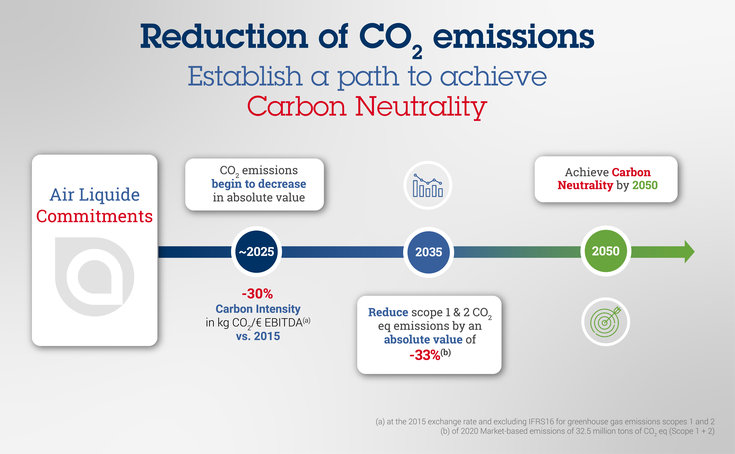Air Liquide joins the fight against climate change, committing to achieve carbon neutrality by 2050
- Sustainability

Air Liquide joins the fight against climate change, committing to achieve carbon neutrality by 2050, starting with a 30% reduction in its emissions by 2025 and allocating 50% of investments to energy transition.
As a sign of the success of our efforts, Air Liquide has been awarded by the CDP (former Carbon Disclosure Project), with an "A-" rating in two categories, climate change and water management. This score recognizes the highest level ("Leadership Level") of the Group's commitment to the environment, which includes some of the most ambitious sustainability goals in its sector.
Additionally, we help our clients to decarbonize their operations by integrating low-carbon products, mainly hydrogen, into our catalog. Hydrogen plays a key role in the energy transition, particularly when it comes to decarbonizing industry and heavy transport, which together account for 43% of global CO2 emissions. By 2050, hydrogen is expected to account for more than 20% of global end-use energy demand.
Air Liquide is confident in the great potential that Mexico has for the production and export of green hydrogen and our 50 years of unique experience in the field make us the main player to make it a reality.
Our knowledge in hydrogen contemplates different industries such as the space industry, aeronautics and heavy industry, dominating the entire value chain: production, transportation, storage and distribution.
Hydrogen Mobility
As a forerunner of hydrogen mobility, Air Liquide, through its Hydrogen Energy business, has been using its existing industrial facilities, technologies and expertise to develop applications for transportation and in particular hydrogen stations for more than 20 years. . Hydrogen-powered electric vehicles are equipped with fuel cells that produce electricity on board the vehicle from hydrogen. With a recharge time of less than 5 minutes, allowing a range of more than 600 km, hydrogen energy is particularly well suited to captive fleets: taxis, buses, vans, forklifts, etc.
- Air Liquide has installed more than 150 hydrogen stations around the world: France, Japan, Korea, Germany, the United States...
- The largest Hydrogen station in the world (Daxing China 2021) is equipped with Air Liquide technology and has a delivery capacity of 5 TPD.
- Air Liquide and Nuevo Pudahuel will collaborate in the development of hydrogen for the decarbonization of the Santiago Airport in Chile. Air Liquide is already collaborating with partners such as Groupe ADP and VINCI Airports on different projects to decarbonize the aviation and airport sectors in France and South Korea.
Low Carbon Hydrogen
Our technologies and our capacity for innovation allow us to offer, depending on the needs of the market, renewable or low-carbon produced hydrogen.
a) By electrolysis from renewable energies (wind, solar, hydraulic) or low-carbon sources.
b) By reforming methane or biomethane with capture and storage of CO2.
Thanks to electrolysis, renewable energies - intermittent by nature - can be converted into hydrogen. As the molecule can be stored and transported so that it can be accessed at any time, hydrogen is a way of not losing the renewable energy that is produced in periods of maximum production.
- In 2021, Air Liquide completed the construction of the largest PEM (Proton Exchange Membrane) electrolyser in the world (Bécancour, Quebec) with a capacity of 20MW.
- Air Liquide Normandy (France) launched a project that includes the installation of a 200MW electrolyser to provide renewable hydrogen to the Normandy refinery.
- In France, in the Dunkirk industrial basin, we have joined forces with ArcelorMittal to develop an ecosystem to sequester up to 3 million metric tons of CO2 from the steel industry.
Air Liquide has signed a memorandum of understanding (MOU) with EDF Renewables, a world leader in renewable energies; Proman, one of the main producers of methanol; SOWITEC, one of the world's largest developers of solar and wind energy; and COPEC, Chile's leading fuel retailer, to support renewable methanol production, using renewable hydrogen as a feedstock, in a variety of industries including mobility, mining, rail and maritime. Located in the northern region of Antofagasta, the Air Liquide plant expects to produce 60,000 tons of e-methanol per year, green hydrogen, and also considers the capture of CO2 from a fixed source. The initiative will operate with a capacity of 80 MW and will receive US$11.7 million from Corfo.
